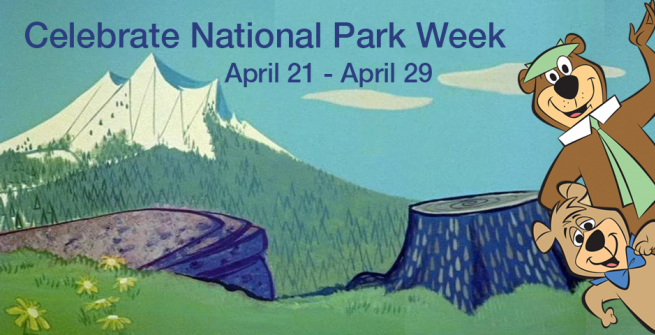The best way to celebrate the National Park System in America is to stand on the hallowed ground of any one of them and just look around. They never fail to fill you with wonder and genuine pride in the treasures that exist in this country. It continues to amaze visitors that despite the crowds and traffic to get inside a National Park it is always worth it to see what has been cherished and protected for over one hundred years. The National Park system is something shared and agreed upon by all Americans which is saying something right there. Plus on April 21, admission is free to all of these places of inspiration and natural beauty. No charge for the priceless!

Very wise men and women have protected these lands and kept them available to Americans since President Ulysses S. Grant declared Yellowstone a national park back in 1872, coincidentally the year the Los Angeles Library Association was founded and began collecting books for the good people in these parts.

Sequoia and Yosemite followed suit in 1890 and the actual National Park Service was created in 1916 with the Organic Act, believe it or not, passed by Congress. Eventually, parks were set aside in 28 states with our own golden state leading the nation with nine national parks that can be reached from Los Angeles in a day’s drive or a few weeks if you want to hoof it. The five dozen parks range from Acadia in Maine to Zion in Utah and represent the natural wonders of our slice of North America, plus Hawaii.

There is Death Valley, the hottest, driest and lowest spot in the U.S. along with Crater Lake in Oregon with azure depths of the most pristine water on earth.
The Everglades in Florida are the largest tropical wilderness in the country and Hawaii Volcanoes National Park has five volcanoes with two active volcanoes that actually increase the landmass of this 323 acre landscape.
For pure breathtaking magnificence, it's hard to beat our own Yosemite with a not too shabby 2,425 foot high waterfall.
The Rocky Mountain National Park in beautiful Colorado has 150 riparian lakes and mysterious Joshua Tree spreads out across the Mojave and the Colorado Desert with a quality of light that is hard to describe but wonderful to behold.
The most visited park is the Great Smoky in North Carolina and Tennessee with a diversity of wildlife unmatched.
Mesa Verde of Colorado boasts over 4,000 archaeological sites where the Pueblo people lived in peace and harmony for over 700 years in cliff dwellings that demonstrate sophisticated construction capabilities.

For sheer majesty, it's hard to top (literally) the Sequoia National Park with the Giant Forest that includes the General Sherman that towers over natural California. This Sequoia tree is the world's largest, measured by volume. It stands 275 feet (83 m) tall, and is over 36 feet (11 m) in diameter at the base.
For those of us who dwell in cities, gazing at phones or sad baseball games, visiting a national park can be a liberating and memorable experience. I still recall the great family road trip my family took when I was a kid that encompassed the Grand Canyon, Bryce and Zion, Yellowstone, the Grand Tetons and my father’s quest to try the assorted dry martinis of the great Southwest./p>

Our library has followed and collected materials on these parks almost from the beginning with books, travelogues, journals, pamphlets, DVDs, books on tape, government documents and maps of every size, shape, and description. Materials on getting there and what to expect when you arrive, abound at the Los Angeles Public Library. This includes hiking, sailing, fishing, bicycling, camping and cozy lodgings within each park. There are over sixty books on the park system alone and materials in languages that embrace the many cultures that enjoy these national treasures.



